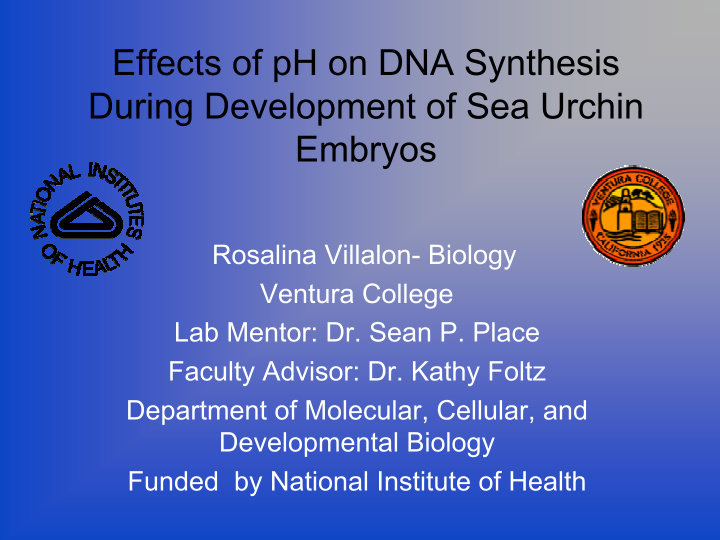



Effects of pH on DNA Synthesis During Development of Sea Urchin Embryos Rosalina Villalon- Biology Ventura College Lab Mentor: Dr. Sean P. Place Faculty Advisor: Dr. Kathy Foltz Department of Molecular, Cellular, and Developmental Biology Funded by National Institute of Health
Why study the effects of pH on DNA Synthesis? – CO 2 + H 2 O → Carbonic Acid – Industrial Revolution → Levels of CO 2 ↑ – Oceanic pH changed from 8.16 to 8.05 in the last 200 years – Conservative models predict ocean pH could drop as much as 0.4 units globally by 2100
Research Goals – Look at early life stages of sea urchin embryos. – Observe the cell cycle and cleavage rates – Search for any effects that pH may have on DNA synthesis. Better understanding on cell cycle progression and embryogenesis
Research Outline • Part 1: – In-vitro Fertilization of sea urchin eggs – Change of pH in sea water to observe any stop in cleavage • Part 2: – Tag DNA and test for DNA synthesis Photo by K. Foltz/ N. Adams
Experimental Design Cleavage pH 8.0 fertilization x pH 7.0 No Cleavage
Cleavage
Experimental Results Effect of pH on Rate of Cleavage Embryos Actively Dividing 100 pH 8.0 pH 7.5 pH 7.0 80 60 (%) 40 20 0 0 30 60 90 120 150 180 210 240 270 Time Post -Fertilization (min)
Research Outline • Part 1: – In-vitro Fertilization of sea urchin eggs – Change of pH in sea water to observe any stop in cleavage • Part 2: – Tag DNA and test for DNA synthesis Photo by K. Foltz/ N. Adams
How does the tagging work? BrdU Thymidine
Incorporation of BrdU to Detect DNA Synthesis Fertilization Fertilization Zhang et al ., 2006 Journal of Cell Science 119, 3491- 3501 Incorporation of BrdU Incorporation of BrdU Incorporation of Fluorescent antibody Incorporation of Fluorescent antibody Fluorescence Fluorescence
Results for DNA Synthesis • Preliminary results show that a pH of 7.5 does not inhibit DNA Unfertilized synthesis • Experiments are currently underway to assess the pH 8.0 inhibition of DNA synthesis at pH 7.0 pH 7.5
Conclusion • pH has a significant effect on development of sea urchin embryos. • pH 7.5 no statistically significant effect on development • Appears to slow down cleavage rate with no effect on DNA synthesis • pH 7.0 completely blocks cleavage • Possibility of multiple cellular pathways are being affected
Future Work • Assess urchin development on a more narrow range of pHs • To investigate what other effects a low pH has on the cell cycle.
Acknowledgements • Dr. Sean P. Place • Dr. Kathy Foltz • The Foltz group: Dr. Michelle Roux, Ian Townley • Dr. Nick Arnold • Special thanks to Samantha Freeman • All the INSET Group
Questions??? www.smbaykeeper.org/.../Purple-sea-urchin.jpg
Recommend
More recommend